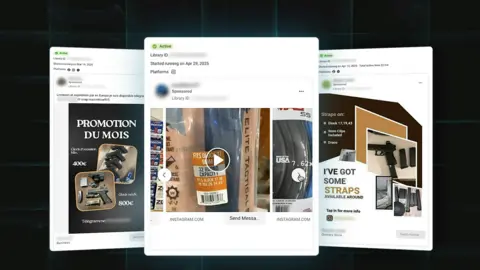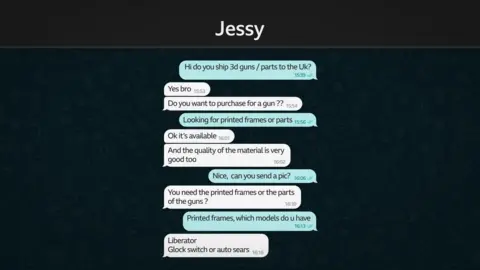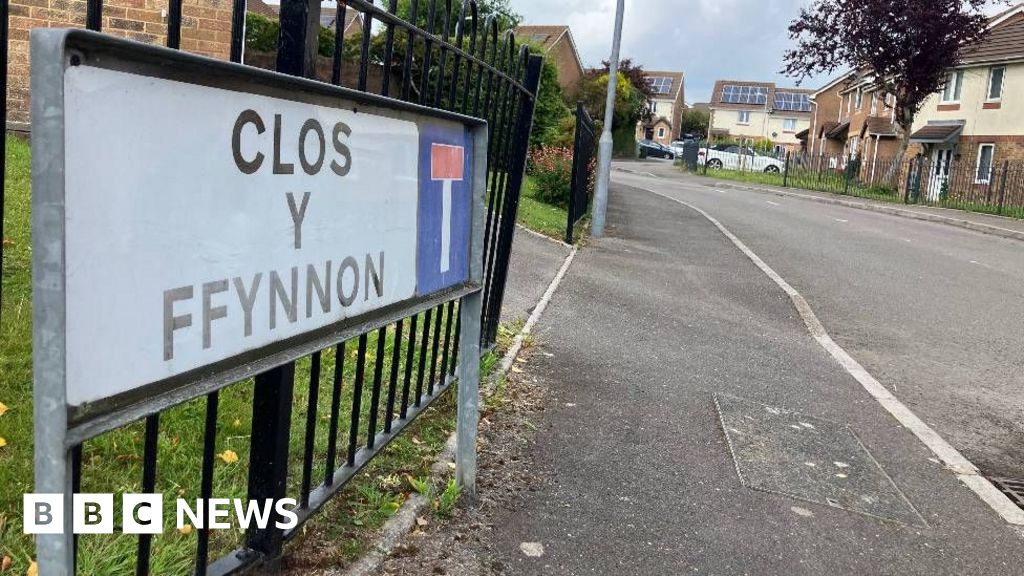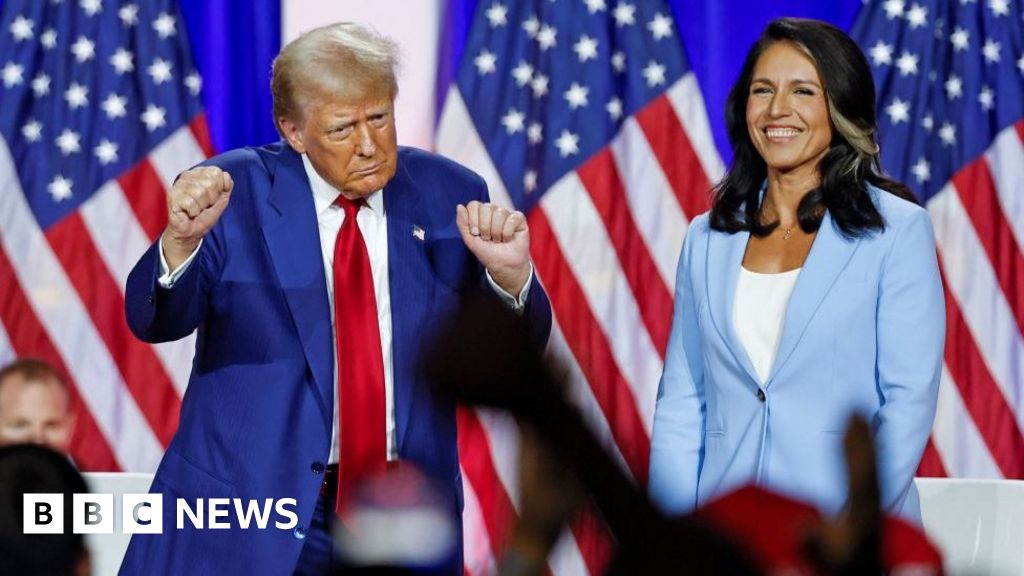 Getty/BBC
Getty/BBC3D-printed guns could become "the weapon of choice" for criminals and violent extremists around the world, an expert has told the BBC. These DIY, untraceable firearms have been recovered in several recent criminal cases, including the alleged use of a partially 3D-printed gun in the killing of United Healthcare CEO Brian Thompson.
BBC Trending has investigated the global spread of 3D-printed guns across social media platforms including Telegram, Facebook and Instagram, as well as websites offering how-to guides.
3D-printed guns, often described as a type of "ghost" gun, are untraceable firearms that can be assembled using a 3D printer, downloadable blueprints and some basic materials. Designed to evade gun-control laws, the technology has advanced rapidly in the last decade, with the latest models capable of firing multiple rounds without their plastic components breaking.
According to Nick Suplina of Everytown, a US-based gun control organisation, 3D-printed guns could become the "weapon of choice" for people planning acts of violence: "The materials have gotten better, the cost has gone down, and the ease of access of these blueprints is at a high," he said.
BBC Trending's investigation began with advertisements for guns on Instagram and Facebook. In October 2024, the Tech Transparency Project, a non-profit that monitors technology companies, found hundreds of gun ads - including for 3D-printed and other ghost guns - appearing on Meta's platforms, in violation of its policies.
Meta declined to comment on the findings at the time. Several months later, BBC Trending found similar gun adverts still showing as active in Meta's ad database.
 Meta/BBC
Meta/BBCMany of these gun adverts directed potential customers to Telegram or WhatsApp channels. On Telegram, we found channels displaying a variety of guns for sale. Some of these appeared to be 3D-printed. One Telegram account with over 1,000 subscribers claimed to ship weapons globally.
BBC Trending contacted the account, which called itself "Jessy", to confirm whether it would be willing to break the law by shipping 3D-printed guns to the UK. Within an hour, Jessy offered us a Liberator or a Glock switch.

A glock switch (also known as an auto sear) is a small, sometimes 3D-printed part that converts a pistol into an automatic weapon.
The Liberator, designed in 2013 by "crypto-anarchist" Cody Wilson, is the world's first widely available 3D-printed gun, capable of firing a single shot.
Jessy claimed he could smuggle the weapon through UK customs, asked for payment of £160 in bitcoin, then suggested a bank transfer to a UK account we couldn't trace.
When we later contacted Jessy, identifying ourselves as the BBC, he acknowledged that selling weapons in the UK is illegal but sounded unapologetic.
"I run my business, sell some straps [slang for weapons] online," he said.
BBC Trending investigates a Telegram channel offering to sell guns
We did not proceed with the transaction to test Jessy's claims. While his casual attitude suggested he might have been a scammer, his ability to advertise on Meta and operate on Telegram highlights apparent loopholes that real gun dealers could exploit.
When contacted, Meta told the BBC that the adverts we highlighted had been "automatically disabled in line with our policies", and that inclusion in its ad library "doesn't necessarily mean the ad is still live or visible".
Telegram said that Jessy's account had been proactively removed for breaching its policies. A spokesperson added: "The sale of weapons is explicitly forbidden by Telegram's terms of service and is removed whenever discovered. Moderators empowered with custom AI and machine learning tools proactively monitor public parts of the platform and accept reports in order to remove millions of pieces of harmful content each day, including the sale of weapons."
Concerningly though, people seeking 3D-printed guns don't need to buy readymade ones through social media. They can assemble their own. Models like the FGC-9 are designed using only 3D-printed plastic and repurposed metal components, with no commercially available gun parts required.
"You are essentially becoming a DIY gunsmith," says Dr Rajan Basra, a researcher at King's College London. However, "It's not as easy as printing off a sheet of A4 paper in your office printer."
As the BBC has previously reported, there are websites offering free step-by-step guides and downloadable blueprints for building 3D-printed guns.
One such guide was written by Matthew Larosiere, a gun rights attorney in Florida. He's associated with the global pro-3D-printed gun community, which has many members in the USA who see the Second Amendment right to bear arms as a human right.
BBC Trending challenged him about why he is sharing information to help people build a lethal weapon.
He replied: "It's just information. It's ones and zeros. The fact that the information has a use case that makes you uncomfortable, I understand and I sympathise with that, but that doesn't make it correct to say it's anything more than information."
Asked about the risk of this "information" being used in a school shooting or massacre, he replied: "I thank God that has not happened." He cited Myanmar as a country where, in his view, 3D-printed guns have served a positive cause.
 Getty
Getty3D printers have been used by Myanmar's rebel groups to make guns
Myanmar is currently the only known case of 3D-printed guns being used in active military conflict. The FGC-9's use by resistance fighters against the junta has been widely reported.
But as BBC Burmese's Hnin Mo discovered, many of these groups have since stopped using 3D-printed guns. This is despite resistance forces producing hundreds of FGC-9s in 2022 and 2023, which cost over ten times less than machine guns on the black market.
The rebel leaders Hnin Mo spoke to cited the junta's tight control over imports of essential materials like glue and metal. Additionally, these groups now have more conventional weapons at their disposal, such as RPGs or machine guns.
The Myanmar example demonstrates the limitations of current 3D-printed guns for military use. But globally, their spread is clear. Several countries are considering laws to criminalise the possession of blueprints. There are also calls for 3D printer manufacturers to block the printing of gun parts, in the same way that conventional printers restrict the printing of currency. But whether such measures can be effective remains to be seen.
Additional reporting by Hnin Mo, BBC Burmese














